Satellite-Aided Analysis of the Position of the Sun Temples and the Dynastic History of the Vth Egyptian Dynasty
Abstract
1. Introduction
2. Materials and Methods
3. Results
3.1. Topographical Alignments at Abusir and Abu Gurab
3.2. The Unexpected Role of King Shesepkara
4. Discussion
- (1)
- Userkaf builds his temple in the very last visibility point from Heliopolis’ western entrance.
- (2)
- Sahura founds the necropolis at Abusir. Userkaf temple signals its existence; he has no need to build a new sun temple, which, therefore, does not exist.
- (3)
- The very same holds for Neferirkara and Neferefra. They align symbolically to Heliopolis, their pyramids, and have no need for a new sun temple, which, therefore, does not exist as well.
- (4)
- Shesepkara cannot build his pyramid to the south-west of the third in Abusir, as it would have been too far in the desert. He then starts building to the north of Sahura but breaks the Heliopolis rule, so he needs a new sun temple at Abu Gurab.
- (5)
- The situation on the ground for Niuserra was really worse: impossible to add a pyramid to the row and no space to the north. His architects managed a clever, albeit intrusive, solution: a new dynastic line and a new connecting line with an existing temple, which was, therefore, renovated without the need for a new one.
 -Akhet is recreated by the Sun setting between the two main pyramids. Akhet was a symbolic horizon composed of two “mountains” with the Sun rising or setting in between, the place where the king united with the Sun God. This name for a temple is unusual, and we may suppose that it directly alludes to an Acket hierophany visible from it. Following this idea—at a purely speculative level—I would like to propose that this unique missing temple might really be in a position that is almost natural and already hinted at by many Egyptologists: the zone between the Userkaf and the Shesepkara/Niuserra temples in Abu Ghorab [33].
-Akhet is recreated by the Sun setting between the two main pyramids. Akhet was a symbolic horizon composed of two “mountains” with the Sun rising or setting in between, the place where the king united with the Sun God. This name for a temple is unusual, and we may suppose that it directly alludes to an Acket hierophany visible from it. Following this idea—at a purely speculative level—I would like to propose that this unique missing temple might really be in a position that is almost natural and already hinted at by many Egyptologists: the zone between the Userkaf and the Shesepkara/Niuserra temples in Abu Ghorab [33].Funding
Data Availability Statement
Conflicts of Interest
Appendix A
| Site | Coordinates |
| Pyramid of Djedefra (Abu Roash) | 30°01′56″ N 31°04′29″ E |
| Pyramid of Khufu (Giza) | 29°58′45″ N 31°08′03″ E |
| Pyramid of Zawiet el Arian | 29°56′24″ N 31°9′5.6″ E |
| Niuserra Sun Temple (Abu Gurab) | 29°54′14″ N 31°11′37″ E |
| Userkaf Sun Temple (Abu Gurab) | 29°54′00″ N 31°11′56″ E |
| Pyramid of Sahura (Abusir) | 29°53′51″ N 31°12′12″ E |
| Heliopolis (West entrance) | 30°07′46″ N 31°18′07″ E |
| Wadi Hof | 29°53′27″ N 31°20′19″ E |
| Coordinates location of the monuments and places discussed in the paper |
References
- Lehner, M. The Complete Pyramids; Thames and Hudson: London, UK, 1999. [Google Scholar]
- Verner, M. The Pyramids: The Mystery, Culture, and Science of Egypt’s Great Monuments; Grove Press: Greenwich, NY, USA, 2002; ISBN 978-0-8021-3935-1. [Google Scholar]
- Goedicke, H. Abusir-Saqqara-Giza in Abusir and Saqqara in the Year 2000 ed.; Barta, M., Krejci, J., Eds.; AVCR: Prague, Czech Republic, 2001. [Google Scholar]
- Nuzzolo, M. The Sun Temples of the V Dynasty: A Reassessment. SAK 2007, 36, 217–247. [Google Scholar]
- Nuzzolo, M. Sun Temples and Kingship in the Ancient Egyptian Kingdom. In Proceedings of the Ninth International Congress of Egyptologists, Grenoble, France, 6–12 September 2004; pp. 1401–1410. [Google Scholar]
- Shaltout, M.; Belmonte, J.; Fekri, M. On the orientation of ancient Egyptian temples: (3) Key points in Lower Egypt and Siwa Oasis, Part I. J. Hist. Astron. 2007, 38, 141–160. [Google Scholar] [CrossRef]
- Magli, G. Architecture, Astronomy and Sacred Landscape in Ancient Egypt; Cambridge University Press: Cambridge, UK, 2013. [Google Scholar]
- Quirke, S. The Cult of Ra; Thames and Hudson: London, UK, 2001. [Google Scholar]
- Nuzzolo, M. Sun Temple of Niuserra in Abu Ghurab: Report of the Season 2018–2019. In Newsletter Centro Interdipartimentale di Servizi per l’Archeologia 11; Università di Napoli L’Orientale: Napoli, Italy, 2020; pp. 269–310. [Google Scholar]
- Abdallatif, T.F.; Abd-All, E.M.; Suh, M.; Mostafa Mohamad, R.; El-Hemaly, I.A. Magnetic tracing at Abu Sir (land of forgotten pyramids), Northern Egypt. Geoarchaeol. Int. J. 2005, 20, 483–503. [Google Scholar] [CrossRef]
- Zhao, Q.; Yu, L.; Li, X.; Peng, D.; Zhang, Y.; Gong, P. Progress and Trends in the Application of Google Earth and Google Earth Engine. Remote Sens. 2021, 13, 3778. [Google Scholar] [CrossRef]
- Baratta, N.; Magli, G.; Picotti, A. The Orientation of the Kofun Tombs. Remote Sens. 2022, 14, 377. [Google Scholar] [CrossRef]
- Parcak, S. Moving from space-based to ground-based solutions in remote sensing for archaeological heritage: A case study from Egypt. Remote Sens. 2017, 9, 1297. [Google Scholar] [CrossRef]
- Potere, D. Horizontal Positional Accuracy of Google Earth’s High-Resolution Imagery Archive. Sensors 2008, 8, 7973–7981. [Google Scholar] [CrossRef] [PubMed]
- Redzwan, G.; Firuz Ramli, M. Geo-referencing the Satellite Image from Google Earth by Relative and Absolute Positioning. Mal. J. Sci. 2007, 26, 135–141. [Google Scholar]
- Petrie, W.M.F.; Mackay, E. Gizeh and Rifeh, Heliopolis, Kafr Ammar and Shurafa; Cambridge University Press: Cambridge, UK, 2013. [Google Scholar]
- Faulkner, R. The Ancient Egyptian Coffin Texts; Aris Phillips: London, UK, 2004. [Google Scholar]
- Lehner, M. A contextual approach to the Giza pyramids. Archiv. Fur Orientf. 1985, 31, 136–158. [Google Scholar]
- Jeffreys, D. The Topography of Heliopolis and Memphis: Some cognitive aspects. In Beitrage zur Kulturgeschichte Ägyptens; Rainer Stadelmann Gewidmet: Mainz, Germany, 1998; pp. 63–71. [Google Scholar]
- Kaiser, W. Zu den Sonnenheiligtümern der 5. Dynastie; MDAIK; Department of Oriental Studies, University of Vienna: Vienna, Austria, 1956; Volume 14, pp. 104–116. [Google Scholar]
- Magli, G. Topography, astronomy and dynastic history in the alignments of the pyramid fields of the Old Kingdom. Mediterr. Archaeol. Archaeom. 2010, 10, 59–74. [Google Scholar]
- Belmonte, J.A.; Lull, J. Astronomy of Ancient Egypt: A Cultural Perspective; Springer Nature: Berlin/Heidelberg, Germany, 2023. [Google Scholar]
- Verner, M.; Bruna, V. Why Was the Fifth Dynasty Cemetery Founded at Abusir? MDAIK 2018, 23, 286–294. [Google Scholar]
- Gabolde, L.; Laisney, D. The Orientation of the Temple of Heliopolis: Geophysical Data and Historical Implications; Mitteilungen des Deutschen Archäologischen Instituts, Abteilung Kairo: Cairo, Egypt, 2018. [Google Scholar]
- Stadelmann, R. Userkaf in Saqqara und Abusir. Untersuchungen zur Thronfolge in der 4. und frühen 5. Dynastie. Arch. Orient. 2000, 9, 529–542. [Google Scholar]
- Verner, M. Who was Shepseskara, and when did he reign? In Abusir and Saqqara in the Year 2000; Bárta, M., Krejčí, J., Eds.; Academy of Sciences of the Czech Republic, Oriental Institute: Prague, Czech Republic, 2000; pp. 581–602. ISBN 978-80-85425-39-0. [Google Scholar]
- Verner, M. Archaeological Remarks on the 4th and 5th Dynasty Chronology. Arch. Orientální 2001, 69, 363–418. [Google Scholar]
- Kaplony, P. Die Rollsiegel des Alten Reiches. Katalog der Rollsiegel II. Allgemeiner Teil mit Studien zum Köningtum des Alten Reichs II. Katalog der Rollsiegel A. Text B. Tafeln; Fondation Egyptologique Reine Élisabeth: Bruxelles, Belgium, 1981; ISBN 978-0-583-00301-8. (In German) [Google Scholar]
- News and Events–Sun Temples Project. Available online: https://www.suntemplesproject.org/news-and-events/ (accessed on 11 November 2013).
- Shaltout, M.; Belmonte, J.A.; Fekri, M. On the orientation of ancient Egyptian temples: (3) Key points at lower Egypt and Siwa Oasis, Part II. J. Hist. Astron. 2007, 38, 413–442. [Google Scholar] [CrossRef]
- Magli, G. Akhet Khufu: Archaeo-astronomical Hints at a Common Project of the Two Main Pyramids of Giza, Egypt. Nexus Netw. J.-Archit. Math. 2008, 11, 35–50. [Google Scholar] [CrossRef][Green Version]
- Magli, G. The Giza ‘written’ landscape and the double project of King Khufu. Time Mind 2016, 9, 57–74. [Google Scholar] [CrossRef]
- Nuzzolo, M.; Zanfagna, P. The Search for the Lost Sun Temples: A Glimpse from the Satellite. Rev. D’égyptologie 2018, 68, 79–108. [Google Scholar]
- Hornung, E.; Krauss, R.; Warburton, D. (Eds.) Ancient Egyptian Chronology. In Handbook of Oriental Studies; Brill: Leiden, The Netherlands; Boston, MA, USA, 2012; ISBN 978-90-04-11385-5. ISSN 0169-9423. [Google Scholar]
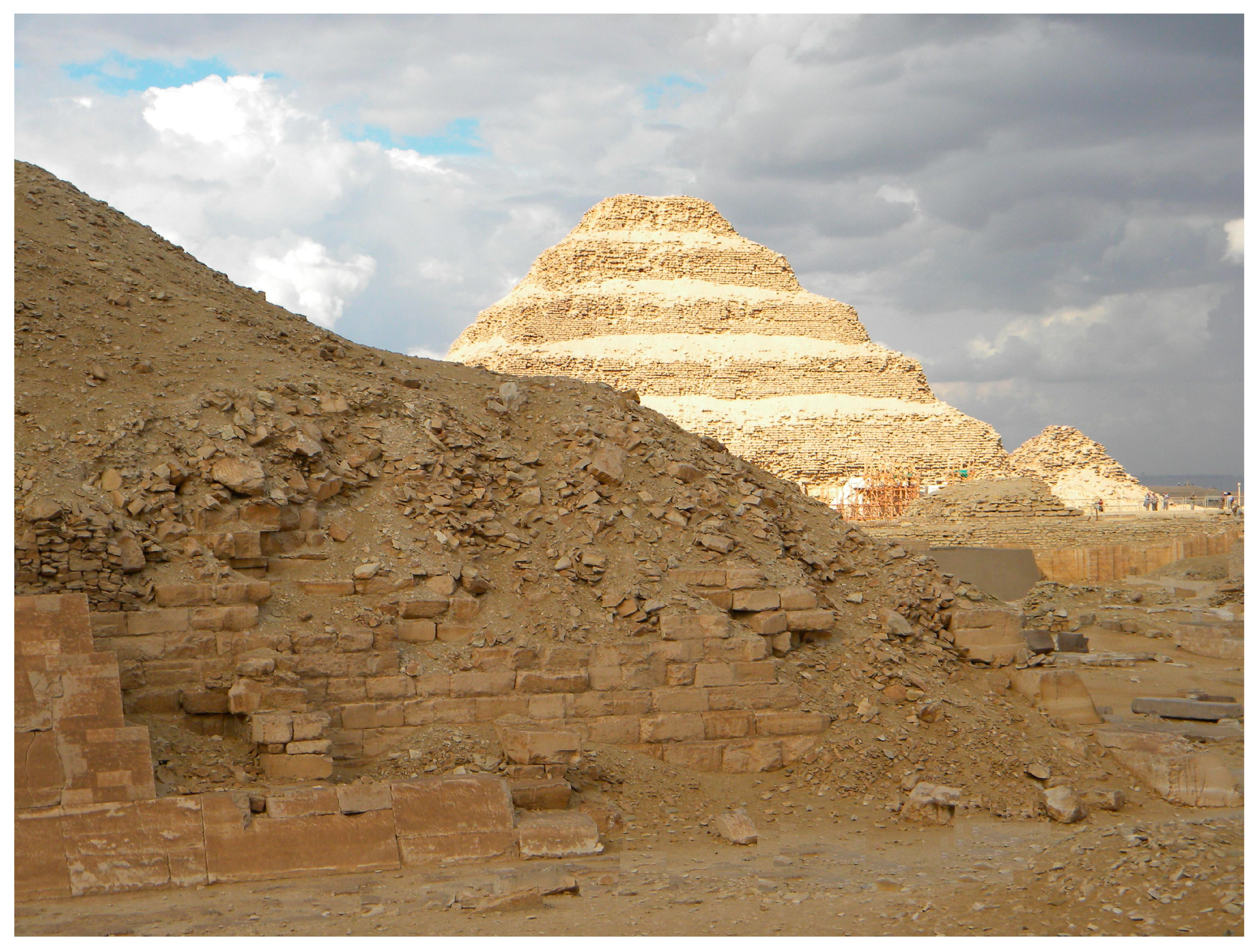
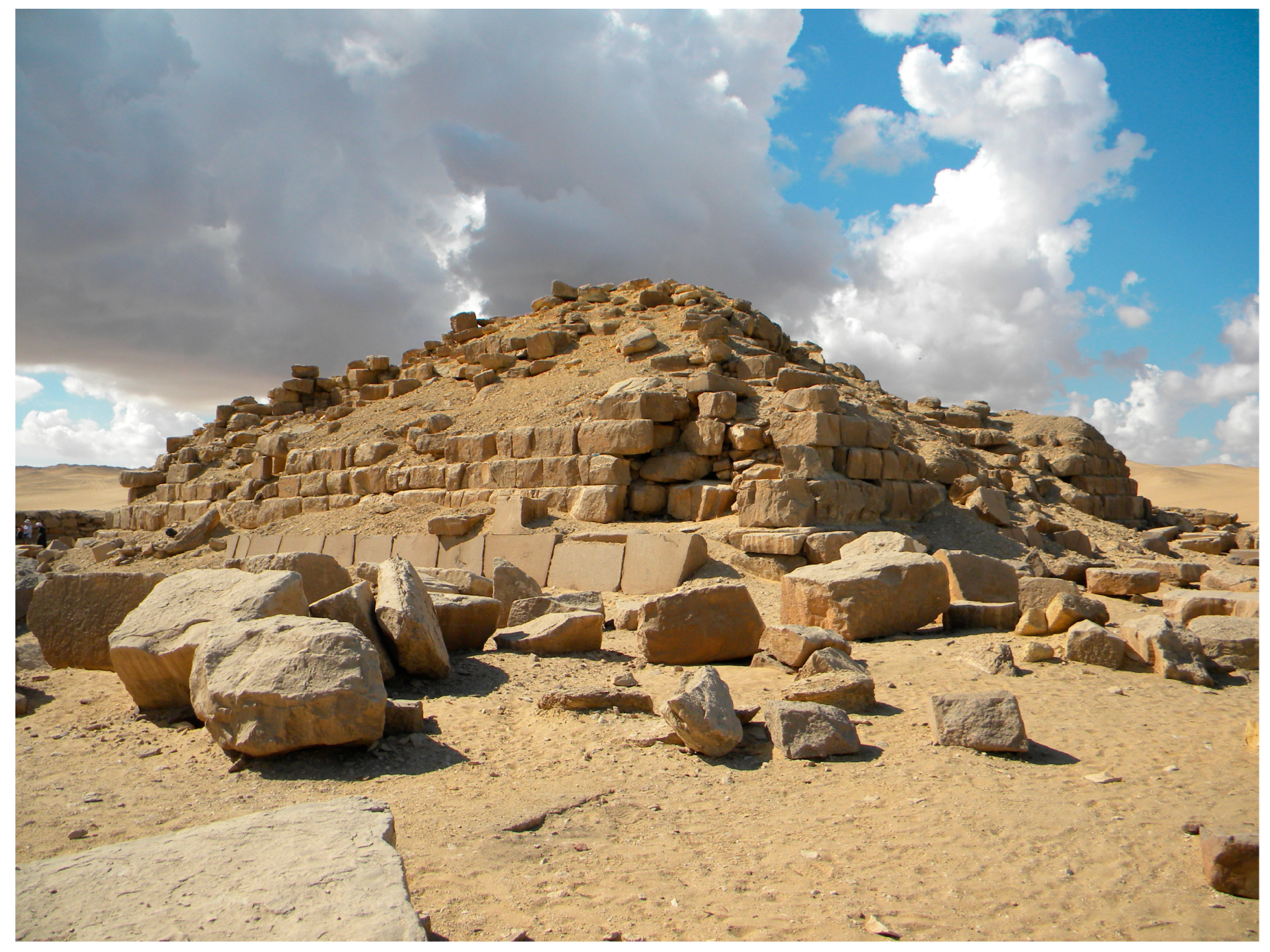

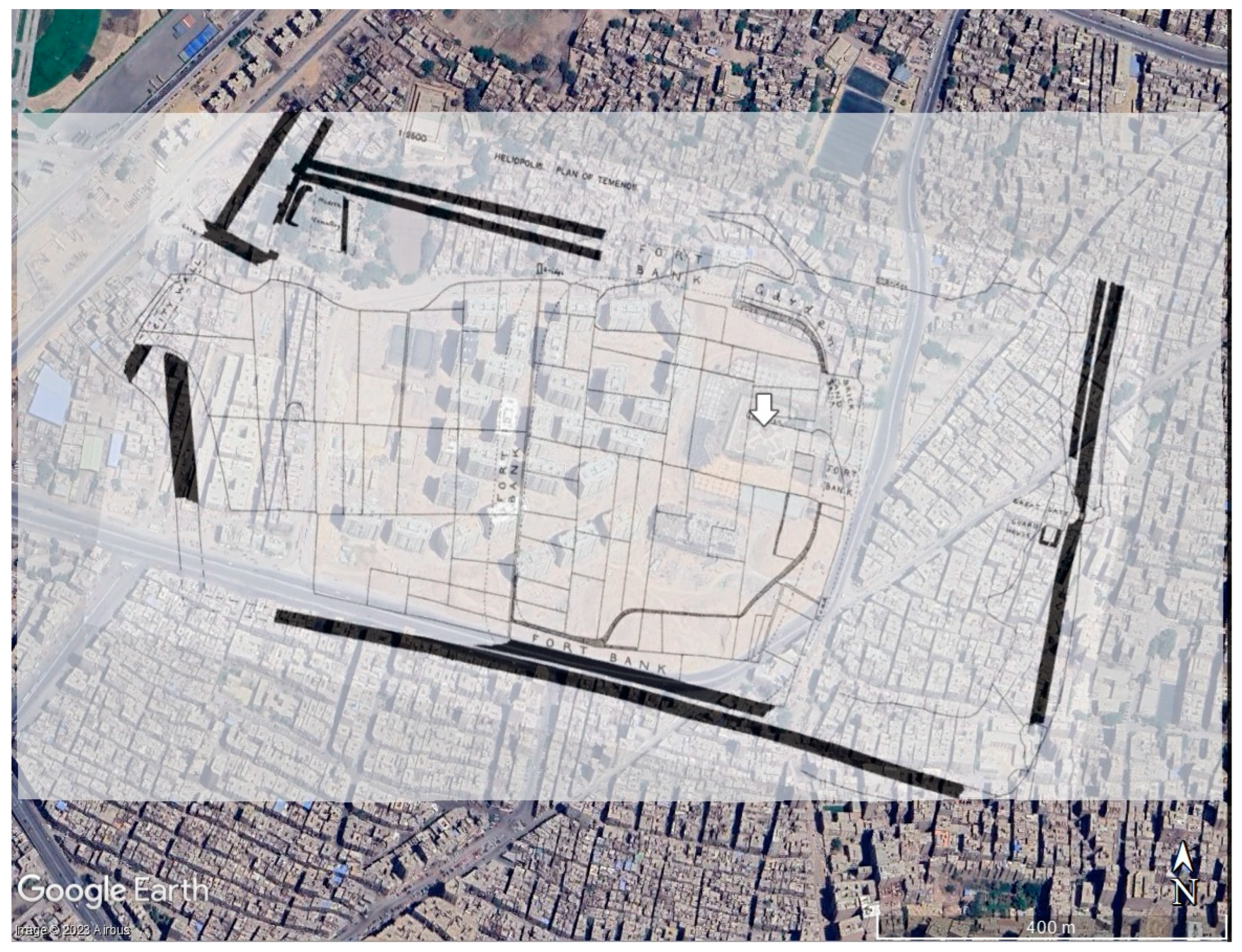

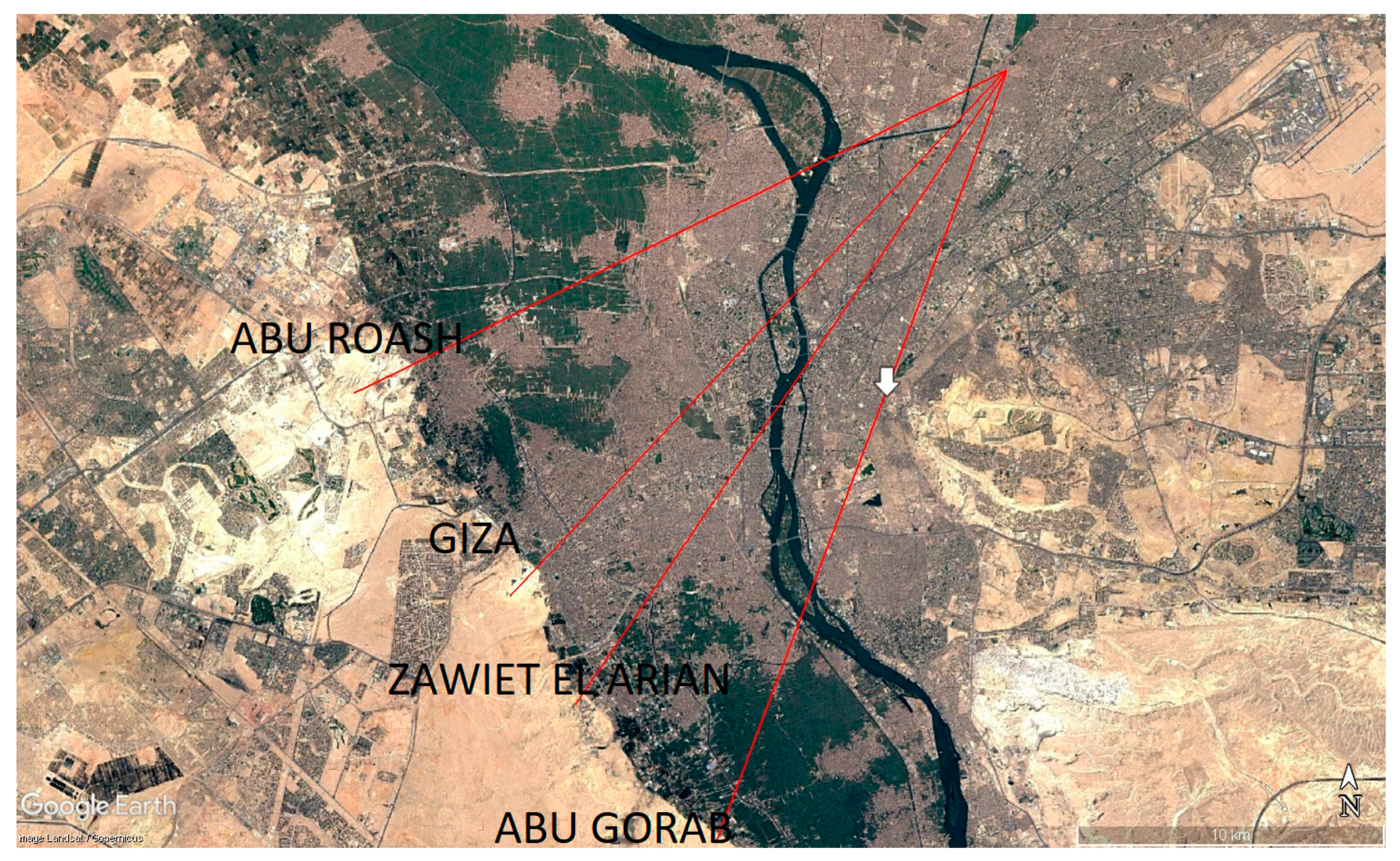
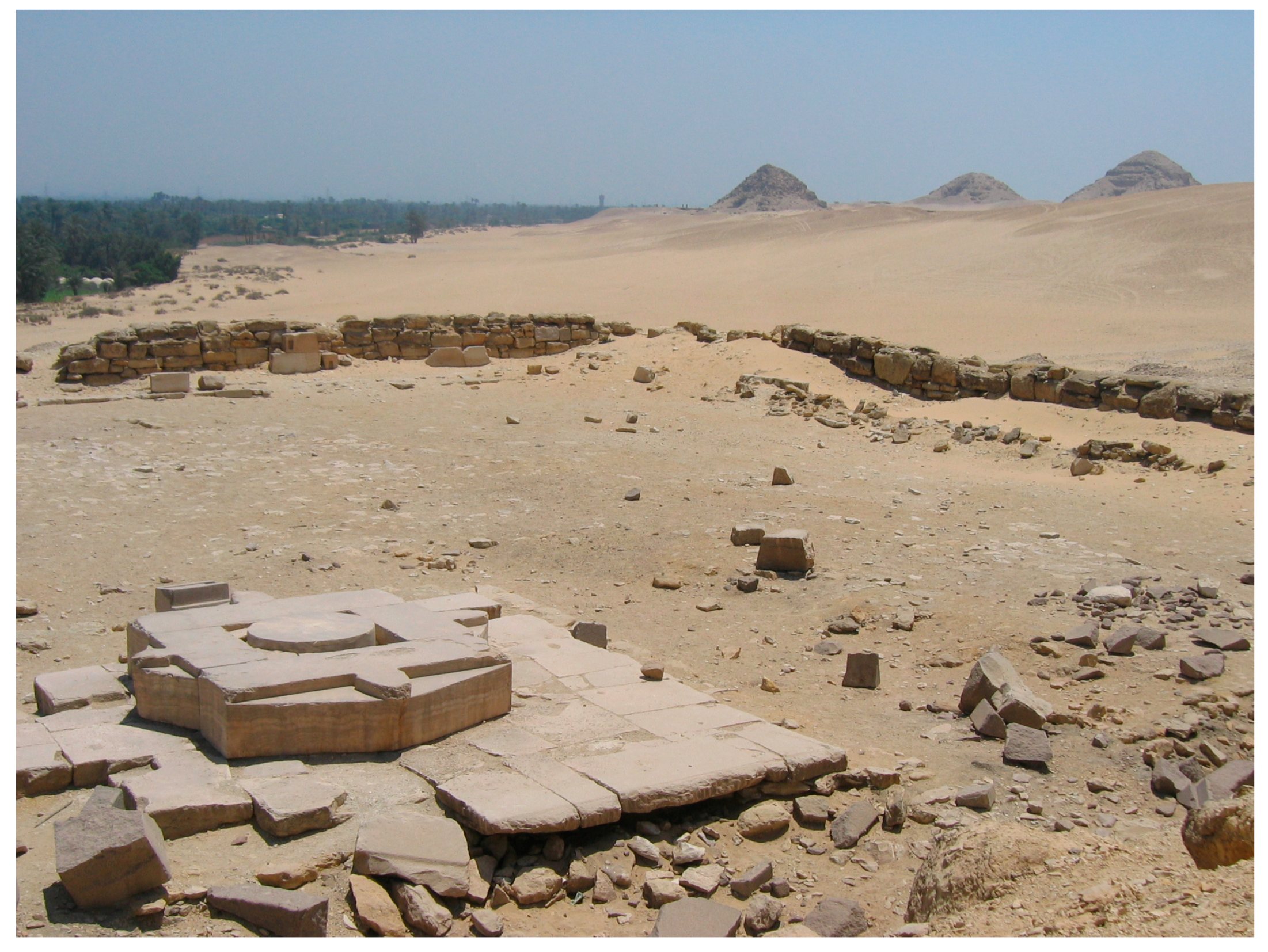
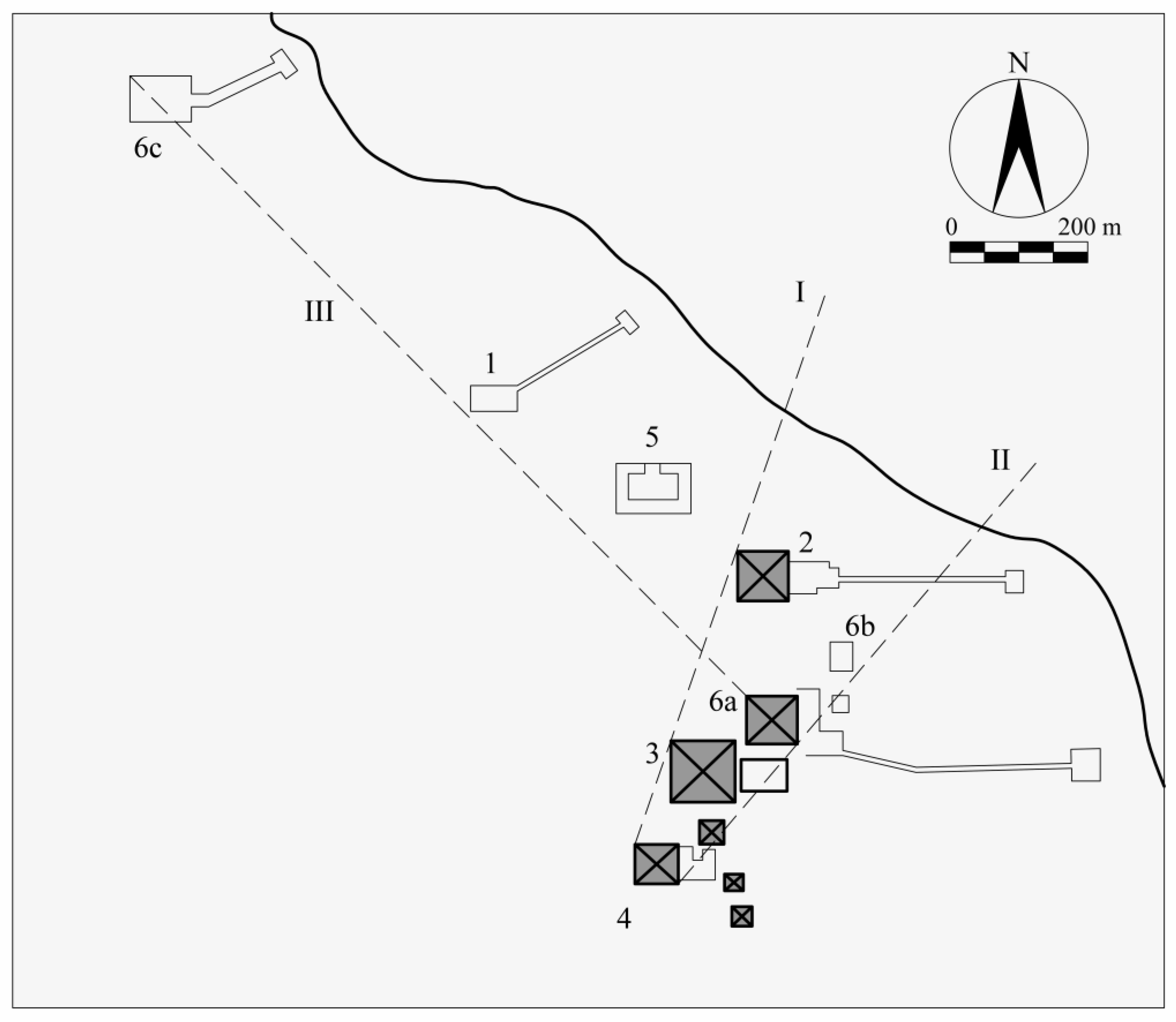
| King Name | Temple Name | Site | Site Proposed in the Present Paper |
|---|---|---|---|
| Userkaf | The Stronghold of Ra | Abu Gurab | |
| Sahura | The Field of Ra | Unknown | Renewal of Userkaf’s |
| Neferirkara | The Place of the Ra Pleasure | Unknown | Renewal of Userkaf’s |
| Neferefra | The Offering Table of Ra | Unknown | Renewal of Userkaf’s |
| Shesepkara | The Heart of Ra is satisfied (unsure) | Abu Gurab | |
| Niuserra | The Delight of Ra | Abu Gurab, rebuilt/renewal of Shesepkara | |
| Menkahour | The Horizon of Ra | Unknown | Abu Gurab |
| List of The Sun Temples of the Vth dynasty |
| Place Name | Azimuth to Heliopolis | Length |
|---|---|---|
| Abu Roash (center of pyramid) | 63.5° | 24.2 km |
| Giza (axis) | 44° | 24 km |
| Zawiet el Arian (center of pyramid’s pit) | 34.5° | 25.5 km |
| Abu Gurab (center of Userkaf temple) | 21° | 27 km |
Disclaimer/Publisher’s Note: The statements, opinions and data contained in all publications are solely those of the individual author(s) and contributor(s) and not of MDPI and/or the editor(s). MDPI and/or the editor(s) disclaim responsibility for any injury to people or property resulting from any ideas, methods, instructions or products referred to in the content. |
© 2023 by the author. Licensee MDPI, Basel, Switzerland. This article is an open access article distributed under the terms and conditions of the Creative Commons Attribution (CC BY) license (https://creativecommons.org/licenses/by/4.0/).
Share and Cite
Magli, G. Satellite-Aided Analysis of the Position of the Sun Temples and the Dynastic History of the Vth Egyptian Dynasty. Heritage 2023, 6, 7156-7169. https://doi.org/10.3390/heritage6110374
Magli G. Satellite-Aided Analysis of the Position of the Sun Temples and the Dynastic History of the Vth Egyptian Dynasty. Heritage. 2023; 6(11):7156-7169. https://doi.org/10.3390/heritage6110374
Chicago/Turabian StyleMagli, Giulio. 2023. "Satellite-Aided Analysis of the Position of the Sun Temples and the Dynastic History of the Vth Egyptian Dynasty" Heritage 6, no. 11: 7156-7169. https://doi.org/10.3390/heritage6110374
APA StyleMagli, G. (2023). Satellite-Aided Analysis of the Position of the Sun Temples and the Dynastic History of the Vth Egyptian Dynasty. Heritage, 6(11), 7156-7169. https://doi.org/10.3390/heritage6110374





